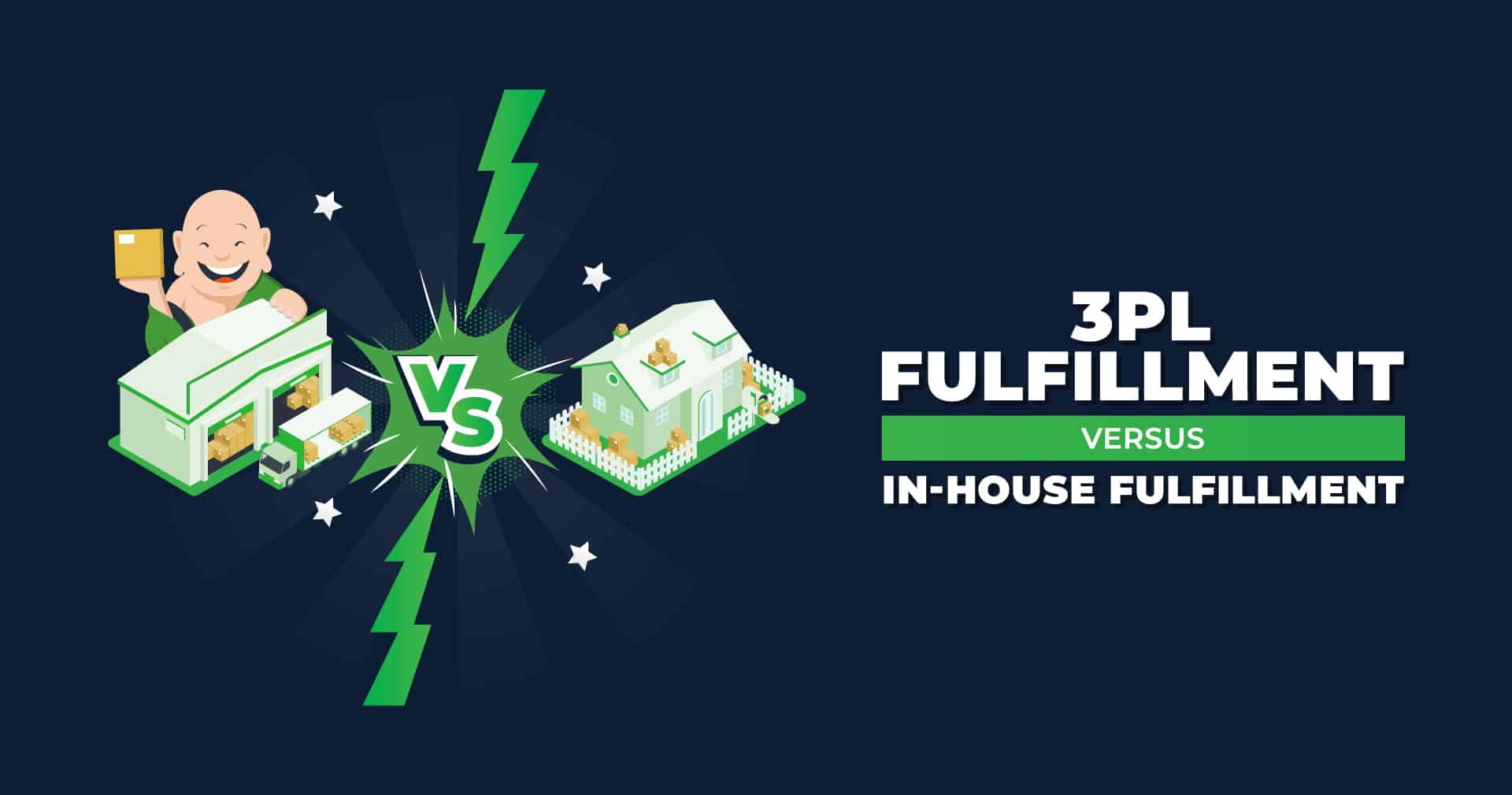3PL Fulfillment Versus In-House Fulfillment
One of the biggest decisions you have to make as a new ecommerce business is how you’re going to fulfill (i.e., pick, pack and ship) customer orders. Most small brands start out fulfilling their own orders from a garage, basement, office, or some other rented space. Eventually, if the business is growing, they’ll come to a fork in the road where they’ll be forced to make a decision: whether to invest in their own warehouse and staff to handle fulfillment services, or whether to partner with a third-party logistics (3PL) and fulfillment company that will handle it for them.
So, what are the main differences between in-house fulfillment and 3PL fulfillment? How do you decide which option is best for your ecommerce brand? That’s what you’re about to find out! Today we’re going to lay out the pros and cons of each method to help you make the right decision.
What Does In-House Fulfillment Entail?
The main difference between in-house fulfillment and hiring a 3PL is that with in-house fulfillment, you own (or lease) the warehouse and manage the entire process yourself. That means you’re responsible for receiving and stocking the inventory, picking and packing the orders, selecting a shipping carrier to ensure on-time delivery, handling returns and customer service.
In-house fulfillment requires capital investments in warehouse space, machinery, and technology in order to operate efficiently and be able to track orders and inventory as they flow through the warehouse. You’ll need to hire and train warehouse workers. Lastly, you’ll need to build relationships with one or more reliable shipping carriers and negotiate shipping rates you can afford.
Pros and Cons of In-House Fulfillment
Depending on the size of your business, in-house fulfillment can make a lot of sense, but because it requires a huge capital investment, it’s not for everyone. Here are the pros and cons of in-house fulfillment.
Pros
- You control all aspects of the fulfillment process, so the quality of the work is in your hands.
- Low-cost option for low-volume shippers, seasonal businesses and customized products.
- You have the freedom to use branded packages and special packaging materials.
- If your products require assembly or special handling, in-house fulfillment let’s you do it your way.
Cons
- Warehouse costs are fixed, so you have to generate enough revenue each month to pay your rent and your employees, maintenance, etc.
- Unless you can fill an entire warehouse, you may be paying for space you don’t need.
- Unless you want to invest in more than one warehouse, all your orders will be shipped from that fulfillment center, wherever it is. A centrally located facility can reduce your shipping costs to either coast, but may be far away from your business headquarters.
- Prioritizing and fulfilling orders from multiple sales channels is difficult and time consuming without a fully integrated warehouse management system to manage incoming orders and automate tasks.
- Some sales channels, such as Amazon’s Seller Fulfilled Prime require shippers to guarantee 2-day shipping to any address, which smaller ecommerce businesses may not be able to manage or afford.
- Labor shortages make it challenging to hire, train, and keep valuable employees.
- Temporary or unexpected spikes in order volume are difficult to staff up for, which creates backlogs and unhappy customers. Important tasks like receiving and processing returns get put on the back burner when things get busy.
- Handling fulfillment operations takes time and money away from other important tasks, such as developing and marketing new products.
- Small order volume makes it difficult to negotiate lower rates on shipping.
- In-house fulfillment centers often promise all their business to one carrier to get the best rate, which can be risky.
How is Outsourcing to a 3PL Different?
When you outsource fulfillment operations to a 3PL, you store your inventory in their fulfillment centers, not yours. You only pay for the space you use. In fact, your products share space with products from hundreds of other small-to-large size ecommerce businesses, while tracking and slotting systems ensure that every SKU has its place. The 3PL hires and trains the pickers and packers, and invests in warehouse automation and technology to speed up fulfillment operations with plenty of room to scale.
A large 3PL such as ShipMonk, has multiple locations across the country or around the world, making it easy to enter new markets. A sophisticated warehouse management system syncs orders from multiple channels and locations, giving each ecommerce client real-time visibility into their orders and inventory levels from a single web portal. Your business benefits from the 3PL’s expertise and modernized facilities, without the capital investment.
Pros and Cons of a 3PL
Pros
- Costs are variable; you only pay for the space you use.
- 3PLs are experts in efficiency and logistics. They invest heavily in people, automation, and technology to reduce errors and improve efficiency. This means they can quickly scale up or down to meet the needs of their clients.
- 3PL warehouse software is designed to integrate with multiple shopping carts, marketplaces and retail systems, as well as most third-party apps and platforms.
- A 3PL can help you build a tech stack that empowers your business for growth, whether you need FBA prep services, B2B/retail distribution, or DTC fulfillment.
- Clients can manage orders and inventory from a single-source software platform, even when orders are coming from multiple sales channels and are fulfilled from multiple warehouse locations.
- A 3PL with multiple fulfillment center locations makes it easy to expand your business geographically, simply by distributing inventory to a warehouse across the country — or across the pond.
- Because they’re shipping thousands of orders per day, 3PLs earn heavily discounted shipping rates and work with all the major shipping carriers, as well as regional and local carriers.
Cons
- Your inventory is being managed by another party.
- Your fulfillment operations are being handled by a partner, so a clear and transparent plan of service agreement is essential.
- Your brand is ultimately responsible for fulfillment, delivery, and customer service, so any mistakes, damage, or delays may reflect negatively on your brand if not handled properly.
Did You Make the Right Choice?
Whether you choose in-house or 3PL fulfillment services, it’s important to track performance to make sure your fulfillment center is meeting expectations. Ecommerce Key Performance Indicators (KPIs) to watch include order accuracy, on-time deliveries, delayed shipments, order lead time, inventory carrying costs, fulfillment costs and shipping costs.
Here are some red flags to watch for:
- Inaccurate orders
- Late shipments
- Late deliveries
- Unexpectedly high shipping costs
- Inventory problems
- Shrinkage and security problems
- Lack of flexibility or special handling capabilities
Knowing When It’s Time to Switch
A 3PL like ShipMonk is built to help clients scale. Robotics, warehouse automation, trained full-time team members, and a robust order and inventory management systems ensure that ShipMonk will never have trouble filling orders during peak season. Most growing ecommerce businesses that switch from in-house fulfillment to a 3PL do so when they reach about 1,000 orders per month. At that point, you need benefits like these:
- Unlimited ability to scale
- Over 99% accuracy rating
- Multichannel fulfillment capabilities
- A robust, easy-to-use software platform
- Specialty services like custom packaging, kitting, assembly
- ShipMonk 2-Day affordable shipping to 100% of continental US
- Virtual Carrier Network (VCN), which automatically selects the best shipping method based on rate, capacity and shipping speed.
- All facilities owned or leased and managed by ShipMonk — no third-party providers to deal with
If you’re evaluating 3PLs, keep ShipMonk on your short list. Contact us for a quote, tour or software demo. We’d love to answer your questions and help you find a 3PL that fits your needs!






